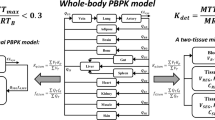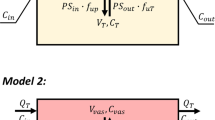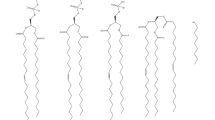Abstract
Permeability-limited two-subcompartment and flow-limited, well-stirred tank tissue compartment models are routinely used in physiologically-based pharmacokinetic modeling. Here, the permeability-limited two-subcompartment model is used to derive a general flow-limited case of a two-subcompartment model with the well-stirred tank being a specific case where tissue fractional blood volume approaches zero. The general flow-limited two-subcompartment model provides a clear distinction between two partition coefficients typically used in PBPK: a biophysical partition coefficient and a well-stirred partition coefficient. Case studies using diazepam and cotinine demonstrate that, when the well-stirred tank is used with a priori predicted biophysical partition coefficients, simulations overestimate or underestimate total organ drug concentration relative to flow-limited two-subcompartment model behavior in tissues with higher fractional blood volumes. However, whole-body simulations show predicted drug concentrations in plasma and lower fractional blood volume tissues are relatively unaffected. These findings point to the importance of accurately determining tissue fractional blood volume for flow-limited PBPK modeling. Simulations using biophysical and well-stirred partition coefficients optimized with flow-limited two-subcompartment and well-stirred models, respectively, lead to nearly identical fits to tissue drug distribution data. Therefore, results of whole-body PBPK modeling with diazepam and cotinine indicate both flow-limited models are appropriate PBPK tissue models as long as the correct partition coefficient is used: the biophysical partition coefficient is for use with two-subcompartment models and the well-stirred partition coefficient is for use with the well-stirred tank model.








Similar content being viewed by others
Reference
Huang SM, Rowland M (2012) The role of physiologically based pharmacokinetic modeling in regulatory review. Clin Pharmacol Ther 91:542–549
Thompson MD, Beard DA (2011) Development of appropriate equations for physiologically-based pharmacokinetic modeling of permeability-limited and flow-limited transport. J Pharmacokinet Pharmacodyn 38:405–421
Sangren WC, Sheppard CW (1953) Mathematical derivation of the exchange of a labeled substance between a liquid flowing in a vessel and an external compartment. Bull Math Biophys 15:387–394
Poulin P, Theil FP (2000) A Priori prediction of tissue: plasma partition coefficients of drugs to facilitate the use of physiologically-based pharmacokinetic models in drug discovery. J Pharm Sci 89:16–35
Poulin P, Theil FP (2002) Prediction of pharmacokinetics prior to in vivo studies. II. Generic physiologically based pharmacokinetic models of drug disposition. J Pharm Sci 91:1358–1370
Leo A, Hansch C, Elkins D (1971) Partition coefficients and their uses. Chem Rev 71:525–616
Sato A, Nakajima T (1979) A vial-equilibration method to evaluate the drug-metabolizing enzyme activity for volatile hydrocarbons. Toxicol Appl Pharmacol 47:41–46
Andersen ME, Clewell H III, Krishnan K (1995) Tissue dosimetry, pharmacokinetic modeling, and interspecies scaling factors. Risk Anal 15:533–537
Poulin P, Theil FP (2002) Prediction of pharmacokinetics prior to in vivo studies. I. Mechanism-based prediction of volume of distribution. J Pharm Sci 91:129–156
Rowland M (1984) Physiologic pharmacokinetic models: relevance, experience, and future trends. Drug Metab Rev 15:55–74
Shen DD (2007) Toxicokinetics. In: Klaassen C (ed) Casarett & Doull’s Toxicology: the basic science of poisons, 7th edn. McGraw-Hill Professional, New York
Isukapalli SS, Roy A, Georgopoulos PG (2007) Physiologically based pharmacokinetic modeling: inhalation, ingestion and dermal absorption. In: Williams PJ, Ette EI (eds) Pharmacometrics: the science of quantitative pharmacology. Wiley-Interscience, Hoboken
Krishnan K, Andersen ME (2007) Physiologically based pharmacokinetic modeling in toxicology. In: Hayes AW (ed) Principles and methods of toxicology, 5th edn. CRC Press, Boca Raton
Mirfazaelian A, Kim KB, Anand SS, Kim HJ, Tornero-Velez R, Bruckner JV, Fisher JW (2006) Development of a physiologically based pharmacokinetic model for deltamethrin in the adult male Sprague-Dawley rat. Toxicol Sci 93:432–442
Godin SJ, DeVito MJ, Hughes MF, Ross DG, Scollon EJ, Starr JM, Setzer RW, Conolly RB, Tornero-Velez R (2010) Physiologically based pharmacokinetic modeling of deltamethrin: development of a rat and human diffusion-limited model. Toxicol Sci 115:330–343
Thompson MD, Beard DA (2012) Physiologically-based pharmacokinetic tissue compartment model selection in drug development and risk assessment. J Pharm Sci 101:424–435
Brown RP, Delp MD, Lindstedt SL, Rhomberg LR, Beliles RP (1997) Physiological parameter values for physiologically based pharmacokinetic models. Toxicol Ind Health 13:407–484
Gueorguieva I, Nestorov IA, Murby S, Gisbert S, Collins B, Dickens K, Duffy J, Hussain Z, Rowland M (2004) Development of a whole body physiologically based model to characterise the pharmacokinetics of benzodiazepines. 1: estimation of rat tissue–plasma partition ratios. J Pharmacokinet Pharmacodyn 31:269–298
Gueorguieva I, Nestorov IA, Rowland M (2004) Fuzzy simulation of pharmacokinetic models: case study of whole body physiologically based model of diazepam. J Pharmacokinet Pharmacodyn 31:185–213
Gueorguieva I, Aarons L, Rowland M (2006) Diazepam pharamacokinetics from preclinical to phase I using a Bayesian population physiologically based pharmacokinetic model with informative prior distributions in WinBUGS. J Pharmacokinet Pharmacodyn 33:571–594
Igari Y, Sugiyama Y, Sawada Y, Iga T, Hanano M (1982) Tissue distribution of 14C-diazepam and its metabolites in rats. Drug Metab Dispos 10:676–679
Igari Y, Sugiyama Y, Sawada Y, Iga T, Hanano M (1983) Prediction of diazepam disposition in the rat and man by a physiologically based pharmacokinetic model. J Pharmacokinet Biopharm 11:577–593
Seng KY, Nestorov I, Vicini P (2008) Physiologically based pharmacokinetic modeling of drug disposition in rat and human: a fuzzy arithmetic approach. Pharm Res 25:1771–1781
Berezhkovskiy LM (2004) Volume of distribution at steady state for a linear pharmacokinetic system with peripheral elimination. J Pharm Sci 93:1628–1640
Everett NB, Simmons B, Lasher EP (1956) Distribution of blood (Fe 59) and plasma (I 131) volumes of rats determined by liquid nitrogen freezing. Circ Res 4:419–424
Benowitz NL (1996) Cotinine as a biomarker of environmental tobacco smoke exposure. Epidemiol Rev 18:188–204
Gabrielsson J, Bondesson U (1987) Constant-rate infusion of nicotine and cotinine. I. A physiological pharmacokinetic analysis of the cotinine disposition, and effects on clearance and distribution in the rat. J Pharmacokinet Biopharm 15:583–599
Robinson DE, Balter NJ, Schwartz SL (1992) A physiologically based pharmacokinetic model for nicotine and cotinine in man. J Pharmacokinet Biopharm 20:591–609
National Center for Biotechnology Information (2012). Pubchem Database. http://www.ncbi.nlm.nih.gov/pccompound. Accessed 16 Apr 2012
Rodgers T, Leahy D, Rowland M (2005) Physiologically based pharmacokinetic modeling 1: predicting the tissue distribution of moderate-to-strong bases. J Pharm Sci 94:1259–1276
Khor SP, Mayersohn M (1991) Potential error in the measurement of tissue to blood distribution coefficients in physiological pharmacokinetic modeling. Residual tissue blood. I. Theoretical considerations. Drug Metab Dispos 19:478–485
Khor SP, Bozigian H, Mayersohn M (1991) Potential error in the measurement of tissue to blood distribution coefficients in physiological pharmacokinetic modeling. Residual tissue blood. II. Distribution of phencyclidine in the rat. Drug Metab Dispos 19:486–490
Boswell CA, Ferl GZ, Mundo EE, Bumbaca D, Schweiger MG, Theil FP, Fielder PJ, Khawli LA (2011) Effects of anti-VEGF on predicted antibody biodistribution: roles of vascular volume, interstitial volume, and blood flow. PLoS ONE 6:e17874
Tsuji A, Yoshikawa T, Nishide K, Minami H, Kimura M, Nakashima E, Terasaki T, Miyamoto E, Nightingale CH, Yamana T (1983) Physiologically based pharmacokinetic model for beta-lactam antibiotics I: tissue distribution and elimination in rats. J Pharm Sci 72:1239–1252
Kawai R, Mathew D, Tanaka C, Rowland M (1998) Physiologically based pharmacokinetics of cyclosporine A: extension to tissue distribution kinetics in rats and scale-up to human. J Pharmacol Exp Ther 287:457–468
Acknowledgments
This work was supported by NIH grant GM094503. MDT is supported by NIH training grant HL007852. The authors thank Dr. Malcolm Rowland (Professor Emeritus, University of Manchester) and Dr. Ivelina Gueorguieva (Eli Lilly and Company, UK) for kindly sharing the diazepam rat dataset. We are also grateful for helpful comments from reviewers.
Author information
Authors and Affiliations
Corresponding author
Rights and permissions
About this article
Cite this article
Thompson, M.D., Beard, D.A. & Wu, F. Use of partition coefficients in flow-limited physiologically-based pharmacokinetic modeling. J Pharmacokinet Pharmacodyn 39, 313–327 (2012). https://doi.org/10.1007/s10928-012-9252-6
Received:
Accepted:
Published:
Issue Date:
DOI: https://doi.org/10.1007/s10928-012-9252-6




